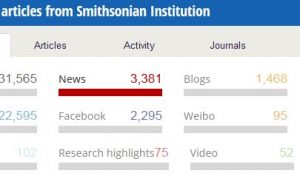Nine Smithsonian scholars are included in Clarivate Analytic’s 2018 Highly Cited Researchers list, an annual list of influential researchers across 21 fields. These Smithsonian scholars join some 4000 researchers from other institutions who appear in the top 1% of scholars in their respective disciplines, based on citations to their publications dating between 2006 and 2016. The Smithsonian Libraries tracks the research output of the Smithsonian Institution and makes it publicly available through Smithsonian Research Online and the newly launched Smithsonian Profiles.
Author: Alvin Hutchinson
Manages the Smithsonian Research Online program, a service which collects published research output authored or created by Institution scholars.

When I was in library school, one concept I remember being covered was the subject-based query versus the known-item query. These were used to represent two basic but very different types of library usage and required of librarians different search and related skills.
Since the earliest days of the Smithsonian Research Online (SRO), we have sometimes thought of the program as a distinct branch libr ary just like any other. The notable exception is that SRO items are not printed materials but rather digital, and we use a different catalog or finding aid for the items. But other than that, the SRO processes materials in much the same way as a typical library by selecting, acquiring and cataloging items as the program has grown.
ary just like any other. The notable exception is that SRO items are not printed materials but rather digital, and we use a different catalog or finding aid for the items. But other than that, the SRO processes materials in much the same way as a typical library by selecting, acquiring and cataloging items as the program has grown.
During the 2016 fiscal year, the Smithsonian Research Online (SRO) program achieved several goals to ensure that publications authored by Smithsonian researchers were more easily discoverable and reused. This blog entry is meant to list some of those accomplishments and describe their significance.
The Smithsonian staff publications below are those that have generated the most media and online  activity for 2015. Congratulations to those authors whose work has been picked up by news, bloggers and other social media users and whose ideas therefore are propagated beyond readership of the source publication.
activity for 2015. Congratulations to those authors whose work has been picked up by news, bloggers and other social media users and whose ideas therefore are propagated beyond readership of the source publication.
This group was culled from among 1500 publications tracked by the online service, Altmetric and assigned a score based on online attention paid by interested parties. Those with the top 25 Altmetric scores are shown here.
The staff at the Max Planck Digital Library released a white paper  earlier this year called, “Disrupting the subscription journals’ business model for the necessary large-scale transformation to open access.” While the title may be a mouthful, the paper put forth a simple idea: That the total worldwide amount spent by libraries on subscriptions to scientific journals is enough to pay the article processing fees if all journals operated on an open access (OA) model. In other words, instead of libraries paying for science journal subscriptions, what if every institution instead diverted that money and used it for article processing fees (APC) for gold open access publishing on behalf of its scholars? (A useful comparison might be that instead of purchasing a car and paying the costs associated with ownership, you instead spent the money on taxis, uber, car rental, home delivery charges, etc.)
earlier this year called, “Disrupting the subscription journals’ business model for the necessary large-scale transformation to open access.” While the title may be a mouthful, the paper put forth a simple idea: That the total worldwide amount spent by libraries on subscriptions to scientific journals is enough to pay the article processing fees if all journals operated on an open access (OA) model. In other words, instead of libraries paying for science journal subscriptions, what if every institution instead diverted that money and used it for article processing fees (APC) for gold open access publishing on behalf of its scholars? (A useful comparison might be that instead of purchasing a car and paying the costs associated with ownership, you instead spent the money on taxis, uber, car rental, home delivery charges, etc.)
Readers of the Sunday Washington Post are familiar with the weekly feature called, ‘5 Myths” where misconceptions about certain timely topics are discussed and debunked. (A recent issue clarified some popular myths about giant pandas, calling on the expertise of Dr. Bill McShea of the Smithsonian Conservation Biology Institute). It may be helpful to point out some things about the Smithsonian Research Online (SRO) program that might be misunderstood by researchers and Smithsonian staff.

